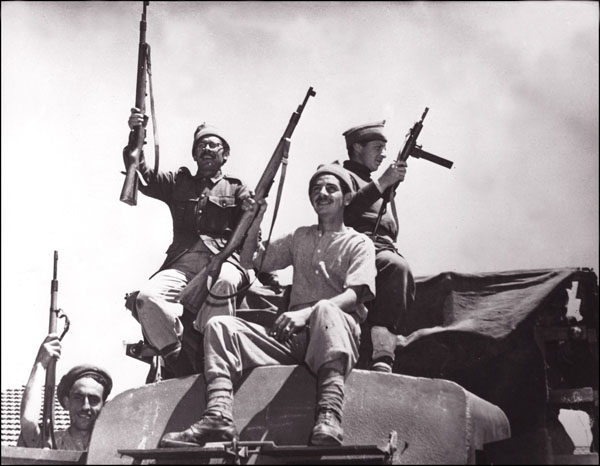Lashing Back – Israel’s 1947-1948 Civil War » History Net: "Israel has fought and won three major wars in its 61-year existence. The best-known today are the Six-day War of 1967 and the 1973 Yom Kippur War. The first war it fought as a nation was in 1948, today referred to by Israelis as the 'War of Independence' and by Palestinian Arabs as 'al-Nakba,' the catastrophe.
But perhaps the most important clashes in Israel's relatively brief history took place in the months preceding its declaration of statehood on May 14, 1948, when the Haganah, the predecessor of the Israel Defense Forces—aided in a minor way by the dissident groups, the IZL and the LHI—battled Arab militias in the towns and villages of Palestine and along the roads linking them. At the time, Great Britain, while nominally charged with maintaining order as it disengaged from the Palestinian territory it had ruled since 1917, focused mainly on withdrawing with minimal casualties and with its political prestige in the Middle East intact, and only occasionally intervened in the fighting."
At stake in this civil war was Israel's existence, and in the early months the Arabs appeared to be winning. By the end of March 1948, most of the Haganah's armored car fleet lay in ruins, and Jewish West Jerusalem, with 100,000 residents, was under siege. Had the run of successful Arab convoy ambushes continued, and had Jerusalem gone under, it seems certain that the armies of the Arab states that invaded the country seven weeks later would have aborted the tiny state before its birth.
Source:
But perhaps the most important clashes in Israel's relatively brief history took place in the months preceding its declaration of statehood on May 14, 1948, when the Haganah, the predecessor of the Israel Defense Forces—aided in a minor way by the dissident groups, the IZL and the LHI—battled Arab militias in the towns and villages of Palestine and along the roads linking them. At the time, Great Britain, while nominally charged with maintaining order as it disengaged from the Palestinian territory it had ruled since 1917, focused mainly on withdrawing with minimal casualties and with its political prestige in the Middle East intact, and only occasionally intervened in the fighting."
At stake in this civil war was Israel's existence, and in the early months the Arabs appeared to be winning. By the end of March 1948, most of the Haganah's armored car fleet lay in ruins, and Jewish West Jerusalem, with 100,000 residents, was under siege. Had the run of successful Arab convoy ambushes continued, and had Jerusalem gone under, it seems certain that the armies of the Arab states that invaded the country seven weeks later would have aborted the tiny state before its birth.
Even before this escalation, Jews had little trust in Palestinian Arabs. The Axis powers, Italy and Germany, had politically and economically supported the Palestine Arab revolt in 1936–1939, against both British rule and the burgeoning Zionist enterprise. And the Palestinian national movement's leader, the anti-Jewish Muslim cleric Haj Amin al-Husseini, sat out the war years (1941–1945) in Germany, received a salary from the Third Reich's foreign ministry, and broadcast calls to the Arab world to join in the anti-British jihad.April 1948, with its back to the wall, the Yishuv (in Hebrew, the Settlement)—as the 630,000-strong Jewish community in Palestine called itself—struck back. In a series of campaigns lasting six weeks, they battled mercilessly with the Palestinian Arab militias and overran dozens of Arab villages and towns. Slowly but surely, the balance of the war began to tip in their favor.By 1947, waves of immigration had brought about half a million Jews to Palestine's shores. Most came from Eastern Europe, fleeing bouts of anti-Semitic legislation and violence—pogroms—in the czarist empire and the resurgence of anti-Semitism in central Europe, cresting with the Holocaust during World War II. Underlying their desire to return to the Land of Israel was an age-old messianic longing for the ancestral territory and the resurrection of Jewish sovereignty.
Source:

No comments:
Post a Comment